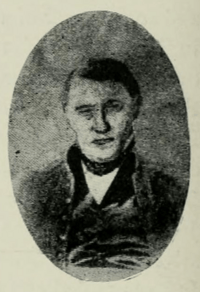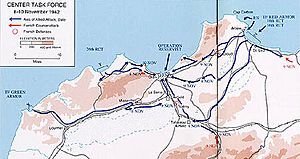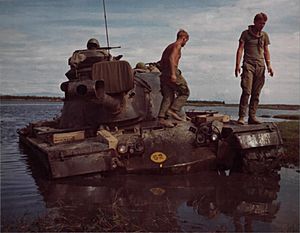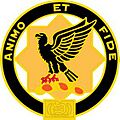1st Cavalry Regiment (United States) facts for kids
Quick facts for kids 1st Cavalry Regiment(1st Regiment of Dragoons) |
|
|---|---|
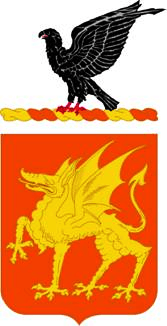
Coat of arms
|
|
| Active | 1833–present |
| Country | |
| Branch | |
| Type | Cavalry |
| Nickname(s) | "1st Regiment of Dragoons" |
| Motto(s) | Animo Et Fide ("Courageous and Faithful") |
| Engagements |
First Dragoon Expedition
Mexican–American War
Vietnam War |
| Commanders | |
| Notable commanders |
Henry Dodge Stephen W. Kearny |
| Insignia | |
| Regimental distinctive insignia | 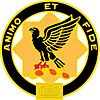 |
The 1st Cavalry Regiment is a special unit in the United States Army. It started a long time ago in the early 1800s as the United States Regiment of Dragoons. Dragoons were soldiers who rode horses but could also fight on foot. Even today, this unit is still called the "First Regiment of Dragoons." Later, in 1855, another unit was called the 1st Cavalry Regiment. But in 1861, it was renamed the 4th Cavalry Regiment. This happened because units were renumbered based on how old they were. The First Dragoons became the 1st Cavalry Regiment because they were the oldest horse-mounted unit still active.
Contents
- The Beginning of US Cavalry
- How the Regiment Was Formed
- Protecting the Frontier
- Fighting in the Mexican–American War
- More Frontier Duties
- The American Civil War
- Back to the Frontier
- Spanish–American War
- The Philippines and Border Duty
- World War II
- After the War
- Vietnam War
- Arctic Cavalry
- Cold War Border Watch (1978–1991)
- Gulf War and Balkans
- War on Terror
- Regiment's Battle History
- Where the Regiment Is Now
- Famous People from the Regiment
- Symbols and Meanings
- Images for kids
The Beginning of US Cavalry
During the American Revolutionary War (1775–1783), American soldiers copied the British army's horse units, especially their well-equipped dragoons. The first horse unit created by the United States Congress was a group of four troops in 1792. These troops were later added to the Legion of the United States.
However, by 1802, these horse units were disbanded because they were too expensive to keep. In 1808, the Regiment of Light Dragoons was formed, and another one was added in 1812. These units fought in the War of 1812, including battles like Mississinewa and Lundy's Lane. But in 1815, Congress decided that horse units were too costly for a standing army, so they were dissolved again.
How the Regiment Was Formed
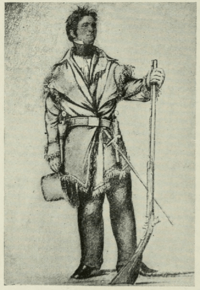
The "United States Regiment of Dragoons" was officially created by a law on March 2, 1833. This happened after another unit, the "Battalion of Mounted Rangers," was disbanded. The Rangers had been formed in 1832 because the country needed horse units to patrol the frontier and respond to conflicts like the Black Hawk War.
Many of the first officers for the new Dragoon regiment came from the Mounted Rangers. In June 1834, the regiment had all its officers. Many of them later became famous generals during the American Civil War. Some of these important leaders included:
- Colonel Henry Dodge: He came from the Mounted Rangers.
- Lieutenant Colonel Stephen W. Kearny: He joined from the 3rd Infantry Regiment.
- First Lieutenant Jefferson Davis: He later became the president of the Confederate States during the Civil War.
The regiment's main base was at Jefferson Barracks Military Post in Missouri. Its different troops were formed in various states like Tennessee, New York, Kentucky, and Ohio. The unit officially became the "First Regiment of Dragoons" in 1836 when a Second Dragoons regiment was created.
Protecting the Frontier
In October 1833, the first five companies of the Dragoons were sent to Fort Gibson, Arkansas Territory. They stayed there through the winter. In June 1834, the regiment went on its first big mission, called the First Dragoon Expedition. During this trip, many soldiers got sick with fever, and about a quarter of the men and officers died.
After this, the companies were spread out to different forts like Fort Leavenworth and Fort Des Moines. Throughout 1835, they were constantly in the field.
The Dragoons' main job was to scout among Native American tribes, especially along the Missouri frontier. They also helped keep peace between settlers and tribes, and even among different tribes. They also built roads and bridges. In 1837, the regiment even decided on the color of horses for each company: black, sorrel (reddish-brown), bay (reddish-brown with black mane/tail), and iron gray.
Colonel Dodge left in 1836 to become the Governor of Wisconsin, and Lieutenant Colonel Kearny took his place. The regiment was not heavily involved in the Second Seminole War in Florida, but some soldiers were injured. In 1837 and 1838, Colonel Kearny led parts of the regiment to deal with the Osage Nation. In 1839, some companies were stationed at Fort Wayne (Indian Territory) and often went out to chase hostile tribes.
Fighting in the Mexican–American War
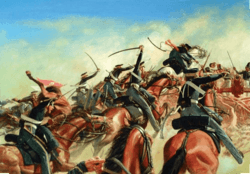
In 1846, General Kearny led the "Army of the West," which included five companies of the 1st Dragoons. This force, about 3,700 men, marched west to New Mexico. They took Santa Fé without much fighting. After leaving some troops there, Kearny continued to California, arriving in December.
On December 6, 1846, Kearny's 150 men fought against 150 California lancers at Battle of San Pasqual. The battle was tough, and the 1st Dragoons lost 3 officers and 14 men, mostly from lance wounds. General Kearny himself was wounded twice. His force finally reached San Diego on December 12, 1846.
Kearny then led troops, including Company C of the 1st Dragoons, from San Diego to Los Angeles. They defeated Mexican forces at the Battle of Río San Gabriel and the Battle of La Mesa in January 1847. After capturing Los Angeles, Mexican resistance in Southern California ended.
Other Dragoon companies also fought. Companies G and I were with Colonel Sterling Price in New Mexico. They helped defeat Mexican forces after the New Mexico Governor, Charles Bent, was killed.
During 1847, Companies A and E were with General Zachary Taylor in Mexico. Company B, while traveling to Santa Fe, fought a large group of Comanche warriors, losing five men. This was the first serious fight the regiment had with frontier Native Americans. Companies D, F, and K also served in Mexico with General Scott. Company F escorted General Scott from Veracruz to Mexico City and was present at several battles.
More Frontier Duties
In September 1848, the 1st Dragoons returned to Fort Leavenworth in Kansas to train new soldiers. In May 1849, they moved further west to guard the dangerous Oregon Trail in Pawnee territory. They had several fights with Pawnee tribes, resulting in many Pawnee deaths and some Dragoon casualties.
In 1850, a group of 1st U.S. Dragoons, led by Captain Nathaniel Lyon, were involved in a conflict with Pomo Native Americans at Clear Lake (California).
In 1853, the newly acquired Southwest region saw more fighting between the US and local Native American tribes. Parts of the 1st Dragoons were sent to New Mexico in 1854. This year was very difficult for the Dragoons, with many casualties.
In March 1854, Companies F and I were stationed in New Mexico. Lieutenant John Wynn Davidson attacked a Jicarilla Apache camp near Taos. The Dragoons were surprised by more warriors and suffered heavy losses. Fourteen men from Company I and eight from Company F were killed, and Lieutenant Davidson and 14 men were wounded.
Throughout 1855, the companies in New Mexico were constantly on the move. Colonel Thomas T. Fauntleroy led expeditions against the Utes and Apaches. In January 1855, Companies B, G, and part of K were attacked at night by Apaches. They lost three men, including their company commander.
Out West, Companies C and E fought in the Rogue River Wars in Oregon. In the Battle of Hungry Hill, they had to retreat after losing 26 men killed and wounded.
In 1855, two new cavalry regiments were created. One was also named "The First Cavalry Regiment." This unit was later renamed the 4th Cavalry Regiment in 1861.
The headquarters for the First Dragoons moved to Fort Tejon, California, in December 1856. For the next five years, the regiment fought in many conflicts with Native American tribes, including the Navajos, Apaches, and other tribes in the Northwest.
The American Civil War
Early Battles (1861–1862)
In 1861, the Civil War began. The War Department decided to rename all horse-mounted regiments as cavalry and renumber them. So, the First Dragoons became the "First Regiment of Cavalry" on August 3, 1861. The original First Cavalry Regiment (formed in 1855) became the 4th Cavalry Regiment.
Most of the 1st Cavalry was moved from the Pacific Coast to Washington, D.C., by steamship through Panama, arriving by January 1862. They joined the Army of the Potomac.
Meanwhile, two companies (D and G) left in Confederate Arizona fought in the Battle of Valverde in February 1862. Company D also fought at Pigeon's Ranch and Battle of Peralta.
The main part of the 1st U.S. Cavalry fought in the Peninsula Campaign in Virginia. At Williamsburg in May, a group led by Captain Benjamin F. "Grimes" Davis charged and pushed back Confederate cavalry, capturing a flag. They lost 13 men. At Battle of Gaines' Mill, they lost 26 more men. The regiment also fought at Battle of Malvern Hill and Battle of Kelly's Ford.
Key Engagements (1863)
In June 1863, at the Battle of Brandy Station, Captain Davis was killed. At Battle of Upperville, the 1st U.S. Cavalry fought in a mounted charge and lost 53 men, mostly from saber cuts. At Battle of Gettysburg, they lost 16 men.
The two companies that had been in New Mexico were reorganized and rejoined the regiment in Maryland in October 1863. After resting, the 1st Cavalry rejoined the Army of the Potomac and fought in several battles, including Manassas Junction and Mine River. They spent the winter doing guard duty along the Rapidan River.
Sheridan's Campaigns (1864)
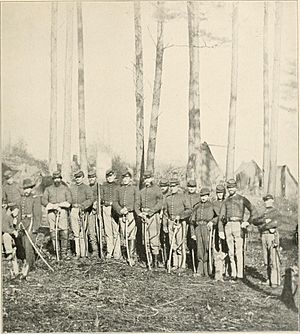
In February 1864, the 1st U.S. Cavalry fought along the Rapidan line and went with General George Armstrong Custer on a raid. When General Philip Sheridan took command of the Cavalry Corps, the 1st Cavalry joined Merritt's Reserve Brigade. They fought at Todd's Tavern and Spotsylvania Court House in May.
The regiment then went with Sheridan on his raid around Richmond, fighting at places like Battle of Yellow Tavern and Battle of Meadow Bridge. At the Battle of Cold Harbor in June, they had severe fighting and lost several men and officers. They also lost 35 men at the Battle of Trevilian Station.
The 1st Cavalry captured an enemy flag at the Battle of Deep Bottom in July. They then moved to Washington, D.C., to help defend against General Jubal Early's attack. In August, they moved to the Shenandoah Valley to rejoin Sheridan. They were involved in almost daily skirmishes and all the important valley battles except Fisher's Hill. From August 16-20, the 1st Cavalry helped destroy crops and seize animals in the valley.
At the Battle of Opequon in September, the 1st Cavalry helped capture two enemy flags and about 200 prisoners. They had 37 casualties. They also played an important part in the Battle of Cedar Creek in October. The regiment then returned to Middletown and continued to fight in skirmishes.
End of the War (1865)
On February 27, 1865, Sheridan began his last expedition through the Shenandoah Valley. The 1st Cavalry fought in the Battle of Waynesboro in March, where the rest of Early's army was captured. They continued to destroy Confederate supplies and railroads.
The 1st Cavalry was present in all the major battles of the Cavalry Corps until the war ended. They fought at Dinwiddie Court House and Battle of Five Forks in March and April. At Five Forks, they charged an enemy position, captured it, and took 200 prisoners. They also fought at the Battle of Sailor's Creek and were present at Battle of Appomattox Court House on April 9, where the Confederate Army of Northern Virginia surrendered.
After the war, the regiment returned to Petersburg, Virginia. They then marched to North Carolina and later returned to Petersburg. On May 8, they left for Washington, D.C., escorting General Sheridan, and took part in the Grand Review of the Armies.
Back to the Frontier
After the Civil War, the regiment was sent to Louisiana and then to California. By January 1866, they were stationed at the Presidio of San Francisco. The different companies were spread out across Oregon, Washington Territory, Idaho, California, Nevada, and Arizona.
Snake War (1866–1868)
From 1866 to 1871, various companies of the 1st Cavalry Regiment were involved in many small fights with Native Americans during the American Indian Wars in the West. From 1866 to 1868, they operated in Oregon, Idaho, Nevada, and California, fighting in the Snake War. This war involved many small battles and clashes across the high-desert plains. It was one of the deadliest Native American wars in the West, with 1,762 deaths.
In December 1866, Lieutenant Colonel George Crook led an expedition of the 1st Cavalry to find Native Americans in their winter camps. At the Battle of Owyhee River in Oregon, Crook's men surprised the Paiutes in their camp. The Native American warriors fought back bravely, but many were shot down. Crook's men continued to pursue them and fought another battle at Steens Mountain.
In February 1867, 25 men of Company B were attacked by hostile Native Americans near Vicksburg Mines in Nevada. In April 1868, Company F killed 32 Native Americans near the Malheur River, Oregon. Later, Crook's troopers, along with infantry and scouts, found a large group of Native Americans in a strong position made of lava rocks in the Infernal Caverns of northern California. Crook's men attacked and, despite heavy losses, managed to take the fortifications. Fighting continued into the night.
Apache Wars (1866–1871)
The 1st Cavalry also fought in the Apache Wars in Arizona from 1866 to 1872. In January 1867, Company M fought a group of 90 warriors at Stein's Mountain in New Mexico, killing 60 and capturing 27. In December 1869, 20 men from Company E killed 11 Mojave Apaches at Fort McDowell, Arizona.
Modoc War (1872–1873)
The Modoc Indians were a small tribe living in northern California. They were ordered to move to the Klamath Indian Reservation but left due to poor treatment. The War Department then sent troops to make them go back, which led to a long and difficult war.
In November 1872, Company B tried to arrest "Captain Jack," a Modoc leader, near the Lost River. The Modocs refused to surrender, and a fight broke out. Eight Modocs were killed, and the company lost two men killed and six wounded.
In January 1873, Companies B and G, along with other troops, marched against the Modocs. The Native Americans attacked them, and a big battle took place on January 17, lasting for many hours. The regiment lost two men killed and two officers and eight men wounded.
The Modocs attacked a wagon train in January, but Captain Reuben F. Bernard of the 1st Cavalry arrived with help, and the Modocs were pushed back. In April, the 1st Cavalry helped drive the Modocs out of their stronghold in the rocks and mountains.
In May, Companies B and F were attacked by Native Americans at Sorass Lake, California, but they pushed them back. Later that month, Companies B, G, and K, with other troops, found a group of Modocs. They chased them for five miles, killing one and capturing many women and children. On May 22, 70 Modocs surrendered. "Captain Jack" was captured later, ending the Modoc War.
Nez Perce War (1877)
In June 1877, Companies F and H were sent to help settlers threatened by the Nez Percé Native Americans led by Chief Joseph. The troops found Chief Joseph's camp and surprised them, but the Native Americans quickly fought back and pushed the soldiers away, killing 33 men.
All companies of the regiment, except two, were then sent to fight the Nez Percés. Companies E and L joined General Howard's command and attacked the camp of "Looking Glass" in July, destroying the village and capturing about 1,000 ponies. The regiment continued to fight the Nez Percés in several battles, including the Battle of Clearwater.
In August, Companies B and L were involved in an attack at Camas Creek, losing one man killed and one wounded. Other companies also fought in the Battle of Canyon Creek in Montana. By the end of November, all companies had returned to their stations.
Bannock War (1878)
In May 1878, the Bannock War began. Company G was the first unit to arrive. The entire 1st Cavalry was ordered into the field. In June, the "Left Column" of four companies attacked the main camp of the hostile Bannocks on Silver Creek. They drove the Native Americans out of their camp, which was then destroyed. The battalion lost two killed and three wounded.
In July, Captain Bernard's battalion attacked about 300 Native Americans on hills near Birch Creek. The cavalry fought on foot and drove the Native Americans from three positions, pushing them several miles into the mountains. Four men were wounded. Lieutenant C. E. S. Wood praised the soldiers, saying they "behaved better or in a more soldierly manner."
The fighting continued as the Native Americans split into smaller groups, which were eventually captured. By the end of October, the companies returned to their permanent stations across the West.
Later Frontier Conflicts (1881–1892)
In 1881, Companies C, G, I, and M were sent to Arizona. In October, Company G fought Apaches near Cedar Springs. The fight lasted until night, and the Native Americans escaped. Company G had two men wounded and 12 horses killed. Companies G and I also had a running fight in the Dragoon Mountains, chasing the hostile forces into Mexico.
In June 1884, the regiment was moved to the Department of Dakota after almost 30 years on the Pacific coast. Their duties had been very hard and often unappreciated.
In 1887, there was a conflict with the "Crows." In November, Colonel Dudley led several troops to arrest "Sword Bearer" and other Native Americans who had fired into agency buildings. The Native Americans charged, but were pushed back. "Sword Bearer" was killed, and the fighting stopped. The Native Americans who were demanded were brought in.
In 1890, the Cheyennes became threatening. Troops B, D, and M were sent to the Tongue River Agency. In September, a white boy was murdered, and attempts to arrest the killers failed. In April, the Native Americans attacked the agency buildings but were pushed back and killed. The regiment also took part in operations against the hostile Sioux in the winter of 1890–1891.
In December 1890, Troop A made an amazing march of 186 miles in 53.5 hours to help another cavalry troop that was rumored to be surrounded by hostile Native Americans. The rumor turned out to be false.
In 1892, the regiment was moved to Arizona.
Medals of Honor During the Indian Wars
The 1st Cavalry Regiment served for many years guarding a vast area. Their duties were very difficult. During this time, 30 soldiers and officers earned the Medal of Honor, the highest military award.
- Eighteen awards were for a single fight against Apaches in the Chiricahua Mountains of Arizona in October 1869.
- Another six were for actions in George Crook's "winter campaign" of 1872–73 in Arizona.
- Other awards were for bravery in various campaigns, including the Battle of Camas Creek and Battle of White Bird Canyon during the Nez Perce War.
Spanish–American War
In 1898, the US became interested in Cuba, which was controlled by Spain. After the USS Maine exploded in Havana Harbor, war began. The 1st Cavalry was sent to Chickamauga Park, Tennessee. The 1st Cavalry and the 10th Cavalry formed a brigade and sailed to Cuba from Tampa, Florida. Because there wasn't enough space on the ship, the soldiers had to leave their horses behind.
They fought in the Battle of Las Guasimas in June and at the Battle of San Juan Hill in July. During the Siege of Santiago, the 1st Cavalry Regiment earned its 61st battle honor. The 1st Cavalry stayed in Santiago until August and then returned to the US.
The Philippines and Border Duty
In 1899, the 1st Cavalry was sent to the Philippines to help after the Boxer Rebellion in China. They arrived in Luzon in September and moved to Santo Tomas. Their job was to scout, escort supplies, and patrol for guerrilla fighters.
In October 1901, 20 troopers chased insurgents, got back stolen goods, and burned a village. In March 1902, Troop B killed several insurgents on Mount Makiling. When the leader of these guerrillas, General Malvar, surrendered in April, the fighting stopped. The 1st Cavalry Regiment returned home in October 1903 and was stationed in Texas. After the 1906 San Francisco earthquake, 1st Cavalry troopers helped with relief efforts.
The 1st Cavalry Regiment returned to the Philippines in 1908 for two years. This time, it was much quieter. They came home in 1910. From 1914, they were stationed in Southern California because of growing tensions with Mexico. In 1915, they moved to Calexico, California to guard the border against raids by the bandit Pancho Villa. They stayed on border duty during World War I and did not participate in the war.
On December 14, 1932, the 1st Cavalry Regiment had its last parade as a horse cavalry unit. The soldiers dismounted and saluted their horses as they left them. The regiment then became the first mechanized unit in the United States Army, meaning they used vehicles instead of horses. They moved to Fort Knox, Kentucky, and became the 1st Armored Regiment on July 15, 1940. They were part of the new 1st Armored Division.
World War II
The 1st Armored Division was one of the first American units to sail across the Atlantic Ocean to fight the Axis countries in World War II. They left New Jersey in April 1942 and arrived in Northern Ireland in May to train. At the start of the war, the 1st Armor was divided into three battalions. The 1st Battalion used M3 Stuart light tanks, and the 2nd and 3rd Battalions used M3 Lee medium tanks.
North Africa (Algeria-French Morocco)
On November 8, 1942, the Allied armies launched Operation Torch, an invasion of French North Africa. The landing crafts couldn't carry the larger tanks, so only the lighter M3 Stuart tanks of the 1st Battalion-1st Armored Regiment (1-1 Armor) were used for the first landings. Their goal was to land east of Oran and quickly move south to capture the Tafaraoui airdrome.
Early on November 8, the tanks of 1-1 Armor landed and quickly drove south, reaching Tafaraoui airdrome by 11:00 AM. They faced enemy fire for the first time in WWII from French anti-tank guns, but quickly outflanked them. They secured the area and captured about 300 prisoners. By the end of the day, American aircraft were using the airdrome.
On November 9, French tanks attacked to retake Tafaraoui airdrome. The 1-1 Armor's B Company and a Tank Destroyer company quickly fought them. They destroyed 14 French tanks, losing only one soldier and one tank that was temporarily damaged.
The next day, American forces pushed into Oran. They came under fire from French anti-tank guns, but C Company, 1-1 Armor, destroyed them. Some tanks ran out of fuel in the city, but infantry soldiers from the 1st Infantry Division secured Oran by noon. After this, many French soldiers joined the Allies.
Tunisia Campaign
After the French stopped fighting, the 1st Armored Division moved east into Tunisia. They faced the German-Italian Panzer Army, which was experienced from years of fighting. On November 25, 1942, the tanks of 1-1 Armor advanced rapidly towards Tunis. C Company destroyed three enemy troop-carriers and captured German motorcycle troops. They then attacked the enemy airfield at Djedeida, destroying twenty enemy planes on the ground.
On November 26, Thanksgiving Day, a German Panzer unit attacked the American positions. 1st Battalion-1st Armored Regiment was the first US armored unit to fight a German armored unit. The American tanks were hidden. A Company spotted the German tanks first, including Panzer IIIs and Panzer IVs. A Company attacked, losing six tanks but distracting the Germans. B Company then attacked the Germans from the rear, destroying six Mark IVs and one Mark III, forcing the rest to retreat. The 1-1 Armor fought well but suffered heavy losses.
On December 1, 1942, German and Italian forces launched a counterattack to retake Tebourba. The 1-1 Armor was forced to retreat. By December 4, the Axis forces had retaken Tebourba, and 1-1 Armor pulled back to the Allied defensive line. On December 10, a German force attacked. C Company was forced to retreat after heavy artillery fire. Enemy tanks broke into the battalion's rear, destroying five M3 Stuarts and five M3 halftracks, forcing 1-1 Armor to withdraw and creating a gap in the Allied line. During the withdrawal, many vehicles got stuck in mud and had to be left behind. By the end of the day, the battalion had only 17 tanks left.
Most of the 1st Armored Regiment was still in England, waiting to be transported. While there, the 2nd and 3rd Battalions received the M4 Sherman tank, which was better than the M3 Lee. These battalions arrived in Algeria on December 21, and by Christmas Eve, the 1st Armored Regiment was complete again.
In January 1943, the 1st Armored Regiment advanced east. In the Battle of Faid Pass on January 30, the 3rd Battalion lost nine tanks to German positions.
Italy Campaigns (1943–1945)
In November 1943, the 1st Armored Regiment moved to Italy and fought in the Naples-Foggia Campaign. The winter months were difficult with mud and strong German resistance, which slowed down Allied progress.
In late January 1944, the 1st Armored Regiment landed in Anzio as part of an Allied plan to get around the German Winter Line. The armored forces broke through the German encirclement in May 1944 after heavy fighting.
After helping to free Rome on June 5, 1944, the 1st Armored Division was reorganized. The 1st Armored Regiment was renamed the 1st Tank Battalion.
The division returned to the front line, and the 1st Tank Battalion steadily advanced north, crossing the Arno River in September. This was followed by tough fighting in the North Apennines, where the rough and cold mountains made it hard for tanks to operate.
Their final action in World War II was the Po Valley Campaign in April 1945. The 1st Tank Battalion was deactivated after VE Day.
After the War
When the Korean War began, the Army started to reactivate units. The 1st Battalion, 1st Armored Regiment, was reactivated as the 1st Tank Battalion. Later, it combined with another unit to reform the 1st Cavalry Regiment in 1957.
Vietnam War
In March 1965, US Marines landed in South Vietnam, starting the main American ground war there. The US military presence grew to fight the communist Viet Cong and North Vietnamese Army. By 1967, many American troops were in Vietnam, and parts of the 1st Cavalry Regiment soon joined the fighting.
1st Squadron, 1st Cavalry
In August 1967, the 1st Squadron, 1st Cavalry Regiment (1-1 Cavalry) was sent to Vietnam. It had three armored cavalry troops and one air cavalry troop (D Troop), which arrived later in July 1968. D Troop was temporarily attached to the 101st Airborne Division and served in I Corps for four years. The 1-1 Cavalry served in areas like Chu Lai, Đà Nẵng, and Tam Kỳ.
Troop E, 1st Cavalry, was activated in 1966 and arrived in Vietnam in December 1967. It fought in many ground battles in Quảng Ngãi and Quang Tin provinces and received an award for its service. Troop E left Vietnam in May 1972.
2nd Squadron, 1st Cavalry
In August 1967, the 2nd Squadron, 1st Cavalry, left Fort Hood, Texas, for Vietnam. They were attached to the 4th Infantry Division in Pleiku. They fought in the Central Highlands in places like Đắk Tô and Kon Tum.
In May 1969, the squadron moved to Phan Thiết and operated in the rice paddies and rubber plantations. They distinguished themselves in actions around Phan Thiết and Song Mao. The 2-1 Cavalry left Vietnam in October 1970.
7th Squadron, 1st Cavalry
The 7th Squadron (Air), 1st Cavalry, was an air cavalry squadron in Vietnam. It had five troops: Headquarters, Alpha, Bravo, Charlie, and Delta. D Troop (the armored cavalry troop) conducted night ambushes, escorted convoys, and performed search missions. Later, they trained South Vietnamese infantry units in air assault missions.
Troops A, B, and C were Air Cavalry units. They used helicopters for scouting, inserting troops, and attacking. They supported the Army of the Republic of Vietnam (ARVN) divisions. In 1970, when President Nixon approved a US/ARVN attack into Cambodia, the squadron, with its four Air Cav troops, formed the advance guard for the ARVN Divisions. After several weeks in Cambodia, they returned to the Delta. All US combat troops were withdrawn by November 30, 1972.
Arctic Cavalry
On December 31, 1972, Troop E was reactivated as a separate air cavalry reconnaissance troop in Alaska. It was deactivated in 1986 but reactivated in 1998 as a ground reconnaissance troop. In 2006, Troop E was reorganized and activated as Headquarters and Headquarters Troop, 5th Squadron, 1st Cavalry Regiment, assigned to the 1st Brigade Combat Team in Alaska.
Cold War Border Watch (1978–1991)
The 1st Squadron, 1st Cavalry Regiment, returned to Europe in December 1978. They took on a new mission: watching the "Iron Curtain" border between West Germany and Czechoslovakia. Based in Schwabach, Germany, the troops rotated through Border Camp Pitman, watching the border for 9 to 10 months each year. They also participated in training exercises.
In 1988, the Squadron moved to Katterbach, Germany, and added aviation units to help with its mission.
Gulf War and Balkans
When Saddam Hussein's Iraq invaded Kuwait, leading to the Gulf War, the 1st Squadron, 1st Cavalry Regiment, moved to Saudi Arabia in January 1991. The 1st Armored Division was arranged in a wedge shape for the advance, and 1-1 Cavalry was at the very front. On February 24, the 1st Cavalry led the way across the border. They covered 244 kilometers (about 150 miles) behind enemy lines in 89 hours of continuous fighting. The 1-1 Cavalry helped destroy four Iraqi divisions, including three from the elite Republican Guard. The squadron had no deaths and only a few wounded. They lost only two M3A2 Bradley fighting vehicles.
The 1-1 Cavalry was also involved in Operation Joint Endeavor starting in December 1995 in the Balkans. A Troop 1-1 Cavalry was the first unit to cross the Sava River during the UN peacekeeping mission in Bosnia and Herzegovina. The 1st Squadron returned to Germany in November 1996.
War on Terror
In April 2003, 1st Squadron, 1st Cavalry, and other units of the 1st Armored Division moved to Kuwait to prepare for Operation Iraqi Freedom. In March 2003, the Squadron took over operations in Baghdad. The Air Cavalry Troops (D, E, & F) provided reconnaissance and security around Baghdad. They stayed in Iraq for 16 months. The Air Cavalry Troops earned several awards for their contributions.
From March 2007 to May 2008, 3-1 Cavalry was deployed east of Baghdad to support President Bush's "Surge."
From September 2008 to September 2009, 5-1 Cavalry was deployed to the eastern Diyala Governorate in Iraq.
From April 2011 to April 2012, 5-1 Cavalry deployed to Kandahar Province in Afghanistan to support Operation Enduring Freedom.
Regiment's Battle History
The 1st Cavalry Regiment has participated in many important campaigns throughout its history:
Mexican–American War
- Battle of Buena Vista
- Siege of Veracruz (Company F only)
- Battle of Cerro Gordo (Company F only)
- Battle of Contreras (Company F only)
- Battle of Molino del Rey (Company F only)
- Battle of Chapultepec (Company F only)
- Capture of Santa Fe (except Company E)
- Battle of San Pasqual (Company C only)
- Battle of Cañada (except Company E)
- Battle of Embudo Pass
- Battle of Río San Gabriel
- Battle of La Mesa
- Siege of Pueblo de Taos
- Battle of Santa Cruz de Rosales (except Company E)
American Indian Wars
- California 1846
- Comanche Wars 1847 (Company B only)
- Nebraska 1849 (Company B only)
- Jicarilla War 1849, 1850, 1851, 1854
- Cayuse War 1851, 1853
- Yuma War 1852
- Comanche Wars 1855
- New Mexico 1855, 1856
- Arizona 1857, 1859, 1866, 1867 (Company E only), 1868, 1869, 1870, 1871, 1872 (except Company B), 1881 (except Company B)
- Washington 1858
- Mohave War 1859
- California 1860, 1868
- Oregon 1860, 1868
- Snake War 1866
- Modoc War 1872
- Sheepeater Indian War 1879 (except Company E)
- Crow War 1887
- Nez Perce 1877
- Bannock War 1878
- Pine Ridge
American Civil War
- Battle of Wilson's Creek 1861 (Company C and D)
- Peninsula Campaign
- Battle of Antietam (except Company E)
- Battle of Fredericksburg
- Battle of Chancellorsville
- Battle of Gettysburg
- Battle of the Wilderness
- Battle of Spotsylvania
- Battle of Cold Harbor
- Battle of Petersburg
- Battle of Valverde
- Battle of Shenandoah
- Battle of Appomattox
- Battle of New Mexico 1862 (except Company E)
- Battle of Virginia 1862, 1863, 1864, 1865
- Battle of Maryland 1863
Spanish–American War
- Santiago
Philippine–American War
- Luzon 1901 (except Company E)
- Luzon 1902 (except Company E)
World War II
- Algeria-French Morocco (with arrowhead)
- Tunisia
- Naples-Foggia
- Anzio
- Rome-Arno
- North Apennines (except Company E)
- Po Valley (except Company E)
Vietnam War
- Counteroffensive, Phase III (except Companies C, D, F, G and H)
- Tet Counteroffensive
- Counteroffensive, Phase IV
- Counteroffensive, Phase V
- Counteroffensive, Phase VI
- Tet 69/Counteroffensive
- Summer-Fall 1969
- Winter-Spring 1970
- Sanctuary Counteroffensive
- Counteroffensive, Phase VII
- Consolidation I
- Consolidation II
- Cease-Fire
Gulf War
- Defense of Saudi Arabia
- Liberation and Defense of Kuwait
Where the Regiment Is Now
- 1st Squadron is the armored reconnaissance squadron for the 2nd Brigade Combat Team, 1st Armored Division at Fort Bliss, Texas.
- 2nd Squadron is the reconnaissance, surveillance, and target acquisition squadron for the 1st Brigade Combat Team, 4th Infantry Division at Fort Carson, Colorado.
- 3rd Squadron was deactivated in 2015.
- 4th Squadron was last assigned to the U.S. Military Academy at West Point and is currently inactive.
- 5th Squadron is the reconnaissance, surveillance, and target acquisition squadron for the 1st Infantry Brigade Combat Team, 11th Airborne Division, at Fort Wainwright, Alaska.
- 6th Squadron is the reconnaissance, surveillance, and target acquisition squadron for the 1st Brigade Combat Team, 1st Armored Division, at Fort Bliss, Texas.
- 7th Squadron was a separate air cavalry squadron and was deactivated in 1976.
- 8th Squadron is the reconnaissance, surveillance, and target acquisition squadron for the 2nd Brigade Combat Team, 2nd Infantry Division, at Joint Base Lewis-McChord, Washington.
Famous People from the Regiment
- John Buford
- Richard S. Ewell
- William J. Hardee
- Jefferson Davis
Symbols and Meanings
Coat of Arms
- Shield: The shield is a yellowish-orange color, which was the color of the Dragoons. The dragon on the shield represents the name "Dragoon." The gold eight-pointed star on the belt around the shield was the Dragoons' symbol until 1851.
- Crest: The crest shows a black hawk rising. This represents the regiment's history.
- Motto: ANIMO ET FIDE means "Courageous And Faithful."
- History: The coat of arms was first approved for the 1st Cavalry Regiment in 1921. It has been updated several times as the regiment's name and role changed over the years.
Distinctive Unit Insignia
- Description: This is a special badge. It has a black hawk rising on a yellowish-orange star. The star is surrounded by a black sword belt with the motto "Animo et Fide" and an old Dragoon belt plate from 1836. The badge is about 1.25 inches (3.18 cm) wide.
- Meaning: The hawk and the yellowish-orange color represent the regiment's origins as the United States Dragoons in 1833. The eight-pointed gold star was the Dragoons' symbol until 1851. The motto means "Courageous and Faithful."
- History: The insignia was first approved for the 1st Cavalry Regiment in 1923. Like the coat of arms, it has been updated as the unit's name and role changed.
Images for kids


